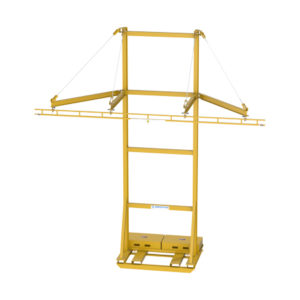GRIFFIN MOBILE SYSTEM PROVIDES FALL PROTECTION FOR A CEMENT PLANT
Products used
Overview
There are many times that a worker in an industrial or construction job can be exposed to a dangerous height. However, a frequently overlooked location is industrial or construction vehicles. Those vehicles can present dangerous heights in a variety of indoor and outdoor locations. But, many workers do not consistently use fall protection because they feel restricted or improperly positioned for their tasks. As a result, they are less likely to use safety equipment if it is difficult to access or annoying to use. Using fall protection for vehicles is important, but it’s difficult to implement when equipment moves and changes location. In production facilities, workers need to service transport vehicles, even when they are not in the maintenance garages. One safety manager at a cement plant had this problem and Rigid Lifelines® had the solution.
Cement production involves the use of large trucks and transportation vehicles. The process begins in mines and quarries where limestone and other minerals are acquired. After the quarry, the limestone must be moved between storage bins and the manufacturing floor. Limestone materials are usually transported by flatbed trucks and railcars. And once the cement has been fully processed, flatbed trucks are used for transporting finished products to retail locations. Tarping, testing, and vehicle cleaning are all important elements of maintaining the equipment used in cement production. As those processes are happening, it’s important that workers have proper fall protection equipment. Both flatbed trucks and railcar hoppers expose workers to dangerous heights. Exposure to height increases the risk that a worker may experience a fall that could cause injury or possibly death.
One cement manufacturing company experienced a worker fall at one of their North American facilities in 2012. The worker fell off of a flatbed truck and suffered some injuries from the experience. As a result, the other branches of cement manufacturing facilities were encouraged to be more proactive about protecting their workers from falls in the loading bay and vehicle maintenance areas. In general, a majority of industrial facilities will have fall protection systems in place. However, if the system makes it difficult for the worker to reach their equipment or work effectively, most workers will be less likely to use the safety equipment. After that cement manufacturer had one facility where a worker fell, other safety managers felt inspired to re-evaluate their current systems. The safety manager at one of the mid-western branches decided to contact Rigid Lifelines to find a more effective fall protection system for his workers.
Solution
The previous fall protection system in the mid-western cement production facility was a self-retracting lanyard (SRL) attached to a single overhead anchorage point on an I-beam that ran across the work area. Workers in the shipping and receiving area were unhappy with the system because it was difficult to access or it made it difficult for them to work. The safety manager realized that this form of fall protection was ineffective for his workers, and he decided to contact an industrial equipment distributor for different fall protection options. After discussing his situation with the knowledgeable distribution staff, he ultimately chose the Griffin™ portable fall protection system by Rigid Lifelines.
Impact
After installation, workers and safety managers noticed an immediate change in employee attitude toward the implementation of fall protection equipment. Within two months, the safety manager started receiving positive feedback about how the Griffin’s portability made it much easier to have fall protection over equipment in a variety of different locations. By placing the Griffin near a flatbed truck, workers were able to access the entire length of a flatbed without repositioning anchorages or inhibiting their ability to do their job.
By having long runway lengths, the Griffin allows workers to travel the entire length of a flatbed truck or railcar with horizontal fall protection present the entire time. By keeping the SRL directly overhead, the likelihood of a worker experiencing a swing fall is dramatically reduced. Plus, the versatility of the Griffin allows workers to have effective fall protection coverage in virtually any location. If workers can have a continuous length of track that covers their workspace, they will be able to keep an SRL overhead to reduce the possibility of swing falls, and they will be more efficient as they navigate their work areas.
One of the biggest benefits of the Griffin is the fact that it’s easy to move and use. By using either a forklift or other towing device, you can transport the Griffin to almost any location that needs fall protection. That portability is powerful because it allows for seamless integration into unusual areas where employees are exposed to potentially dangerous heights. Even without fall protection training, most workers find the Griffin system simple and quick to incorporate into their routine. And when fall protection is accessible and efficient, everyone will find it easier to implement a safer workplace attitude.


